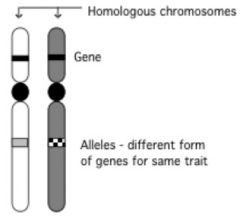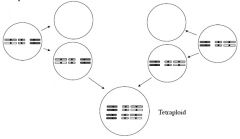![]()
![]()
![]()
Use LEFT and RIGHT arrow keys to navigate between flashcards;
Use UP and DOWN arrow keys to flip the card;
H to show hint;
A reads text to speech;
26 Cards in this Set
- Front
- Back
|
Homologous Chromosomes |

Two genes for one trait - One from male - One from female Identical genes(homozygous) or Different genes(heterozygous) - Called alleles |
|
|
Genetics - Genotype |
Genetic makeup of the trait. - FF, Ff, ff - YY, Yy, yy |
|
|
Genetics - Phenotype |
Outward appearance of the trait. - Ear lobes (free or attached) - Seed color (yellow or green) |
|
|
Genetics -Dominant / Recessive |
Homozygous dominant - YY (Yellow seeds) Heterozygous - Yy (Yellow seeds) Homozygous recessive - yy (Green seeds) |
|
|
Genetics - Incomplete dominance (blending) |
Incomplete dominance (blending) - Red flowers AA - Pink flowers Aa - White flowers aa |
|
|
Genetics - Polygenic inheritance |
Polygenic inheritance - More than one gene is involved in the trait - Human skin color - Corn seed color at least 4 genes |
|
|
Genetics - Polygenic Example Y - timing of chlorophyll elimination (Y - early; y - normal) R - color of carotenoids (R - red; r - yellow) C - regulation of carotenoid deposition (C - normal; c1, c2 - loweredconcentration) |
*This leads to a few possible genotypes producing interestingphenotypes: * Y- rr c1c2 - pale yellow * Y- rr Cc2 - darker yellow * yy rr CC - green * Y- R- CC - red * yy Rr CC - purple * Y- Rr Cc2 - pale yellow |
|
|
DNA genetic material |
- Sequence of four nucleotides
- Adenine, cytosine, guanine, and thymine |
|
|
Transcription |
DNA codes for messenger RNA |
|
|
Translation |
RNA sequence to sequence of amino acidsin proteins |
|
|
Evolution - Natural Selection |
- Many variations within a population - Mutations and meiosis - More individuals are produced then surviveand reproduce. - Those individual with favorable variations areselected by the environment and reproduce. - Over a long period of time the species will fitthe environment. - End result is many species fitting into manyspecific environments. |
|
|
Natural selectionTypes |
1) Directional 2) Stabilizing 3) Disruptive |
|
|
Artificial Selection |
1. Selective breeding 2. Hybrids 3. Polyploidy 4. Recombinant DNA - Genetically modified foods |
|
|
Selective Breeding |
Throughout human history Teosinte to corn Pistachios to grow in California Rapeseed - Canola oil - Low erucic acid and glucosinolates (1974) Marijuana - Bushier plants and more psychoactive THC |
|
|
Hybrids |
Hybridization within a species - Out-crossing leads to genetic variability - Inbreeding or self-fertilization leads to lessgenetic variability or identical homozygousindividuals -Produce a more standard or uniform plants andseeds. -The offspring of two inbred plant parents -Produce hybrids that more often have larger seedsor fruit. This is hybrid vigor. |
|
|
Hybrids - Example |
Hybrids can also occur between two speciesNatural hybridization Black sage + White sage = Hybrid Artificial Selection Grapefruit + Tangerine = Tangelo Wheat + Rye = Triticale Plum + apricot = pluot |
|
|
Animal Hybrids - Mule |
•Sterile •Donkey 62 chromosomes (31 pairs) •Horse 64 (32 pairs) •Mule and hinny each have 63 chromosomes•Many pairs are unevenly matched •The donkey and horse chromosomes arealmost completely unable to pair up atmeiosis to produce viable sperm and eggs |
|
|
Meiosis |

- Reductiondivision - 2N (diploid) to 1N (haploid) - Increases geneticvariation |
|
|
Polyploidy |
- Increase in chromosome numbertetraploid, hexaploid or octaploid. - Mechanism of polyploidy isnon-disjunction. - Same number or different number ofchromosomes. |
|
|
Non-disjunctioncause of polyploidy |

|
|
|
Polyploidy |
- Larger plants, fruit, and or seeds - Occurs naturally by accident - Occurs through genetic selection ormanipulation - Drug colchicine - Cotton, Easter lily - tetraploid - Wheat - hexaploid - Strawberry - octaploid |
|
|
Recombinant DNA |
- Addition of other plant, animal or bacterialgenes (DNA segment) into genome ofanother plant species. - The use of plasmids or small circular sectionsof DNA. - Incorporate desired gene into plasmid DNA - Infect into bacteria DNA. - Bacteria infect the plant with the plasmid andhopefully insert plasmid and desired DNA intoplant genome. |
|
|
GMF 2006 |
7 million farmers in 18 countries United States Don’t label foods as GMO Brazil India Canada China Paraguay South Africa |
|
|
Genetically Modified Foods |
Herbicide (Roundup Ready) resistant 90% Soybeans, 2/3 cotton, ¼ corn, and rapeseed Insect resistance (Bacillus thuringiensis Bt) |
|
|
GMF - Benefits |
Enhanced taste and quality of food Vitamin A in rice Tomatoes with higher lycopene content Reduced maturation time Increased nutrients and yields Stress tolerance Improved resistance to disease, pests, andherbicides Tolerance to cold Tomatoes and strawberries Production of vaccines |
|
|
GMF - Controversies |
Potential human health impacts, including allergens,transfer of antibiotic resistance markers, unknowneffects Unintended transfer of transgenes through crosspollination Unknown effects on other organisms Corn pollen toxic to Monarch butterflies Loss of flora and fauna biodiversity Domination of world food production by a fewcompanies Tampering with nature by mixing genes among species |

